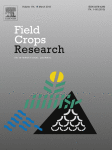View Item
- xmlui.general.dspace_homeCentros Regionales y EEAsCentro Regional CórdobaEEA ManfrediArtículos científicosxmlui.ArtifactBrowser.ItemViewer.trail
- DSpace Home
- Centros Regionales y EEAs
- Centro Regional Córdoba
- EEA Manfredi
- Artículos científicos
- View Item
Genetic improvement of peanut in Argentina between 1948 and 2004: links between phenology and grain yield determinants
Abstract
tIn the mid 1970s, there was a shift in peanut cultivars used in Argentina, from cultivars with erectgrowth habit (CEGH) to those with procumbent growth habit (CPGH), which improved seed yield, butalso lengthened growth cycle. However, there is no information on (i) the partitioning of thermal time(TT) requirements between vegetative and reproductive phases, as well as between reproductive sub-phases representative of the seed set and seed-filling
[ver mas...]
tIn the mid 1970s, there was a shift in peanut cultivars used in Argentina, from cultivars with erectgrowth habit (CEGH) to those with procumbent growth habit (CPGH), which improved seed yield, butalso lengthened growth cycle. However, there is no information on (i) the partitioning of thermal time(TT) requirements between vegetative and reproductive phases, as well as between reproductive sub-phases representative of the seed set and seed-filling periods, and (ii) the effect of developmental changeson growth traits. Field experiments were performed to compute TT, grain yield determinants (i.e., seednumber and seed weight), and other related physiological traits. Eight cultivars released between 1948and 2004 were evaluated. The introduction of CPGH produced a lengthening (31%) of peanut growth cycle(S–R8), which was more pronounced for the reproductive phase (+39% for R1–R8) than for the vegetativephase (+17% for S–R1). This trend held for pod-set (R3–R6.5: +37%) and seed filling (R5–R8: +57%) sub-phases. It also held (CPGH > CEGH) for the rate of flower production (+80%), total flower number (+36%)and number of pods per plant (+117%), and consequently for the fertility index (+56%). The enhancedseed number of CPGH was related to (r2= 0.55, P < 0.001) the variation in crop growth rate during theseed set period (CGRR3–R6.5), but not to the duration of this period. Variations in CGRR3–R6.5were partiallyexplained by differences in cumulative IPAR, which were linked to the duration of the R3–R6.5 period aswell as to maximum light interception fraction. These trends may have management as well as breedingorigins. Introduction of the procumbent habit enhanced seed weight (CPGH > CEGH) and seed-fillingduration markedly, but had no effect on seed-filling rate. Seed weight, however, was positively relatedto this rate (P < 0.01) and exhibited a negative trend in response to the duration of the period. Lack ofsource limitations on seed filling suggest that future breeding efforts should focus on the increase of seednumbers and the reduction of seed filling duration
[Cerrar]

Author
Haro Juarez, Ricardo Javier;
Baldessari, Jorge Javier;
Otegui, Maria Elena;
Fuente
Field crops research 174 : 12-19. (March 2015)
Date
2015-02-03
ISSN
0378-4290
Documentos Relacionados
Formato
pdf
Tipo de documento
artículo
Proyectos
(ver más)
INTA/PNIND/1108062/AR./Introduccion de variabilidad y mejora genética continua de los cultivos industriales.
Palabras Claves
Derechos de acceso
Restringido
 Excepto donde se diga explicitamente, este item se publica bajo la siguiente descripción: Creative Commons Attribution-NonCommercial-ShareAlike 2.5 Unported (CC BY-NC-SA 2.5)
Excepto donde se diga explicitamente, este item se publica bajo la siguiente descripción: Creative Commons Attribution-NonCommercial-ShareAlike 2.5 Unported (CC BY-NC-SA 2.5)

